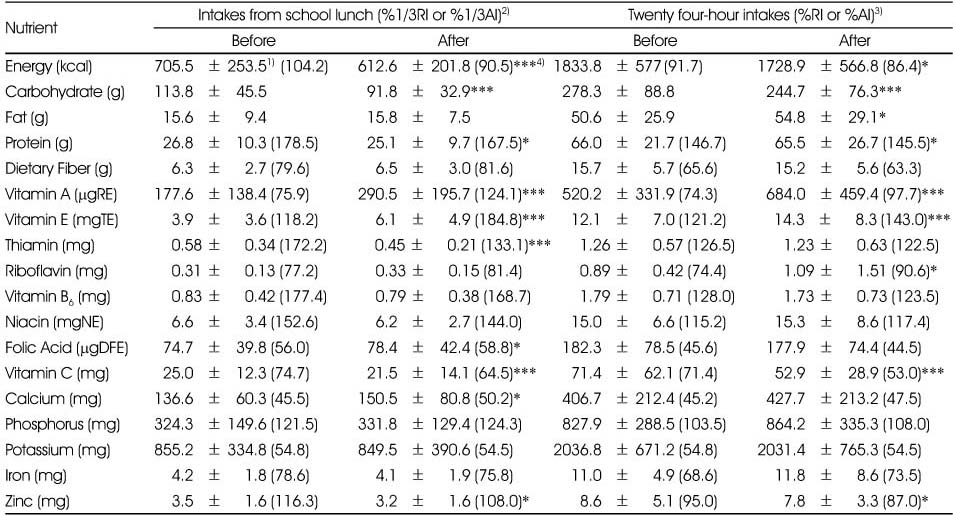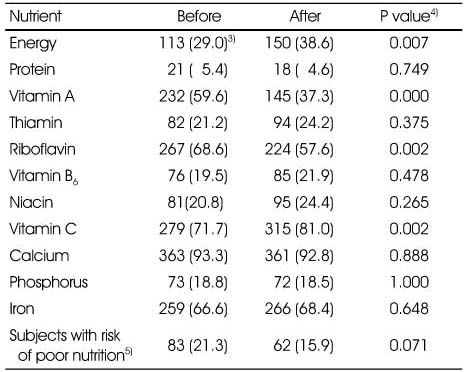References
1. Ahn Y, Kim HM, Kim KW. A study on weight control, nutrition knowledge, dietary attitudes and eating behaviors among high school female students. Korean J Community Nutr 2006. 11(2)205–217.
2. Cho SH, Yu HH. Nutrition knowledge, dietary attitudes, dietary habits and awareness of food-nutrition labelling by girl's high school students. Korean J Community Nutr 2007. 12(5)519–533.
3. Gould R, Russel J, Barker ME. School lunch menus and 11 to 12 year old children's food choice in three secondary schools in England-Are the nutritional standards being met? Appetite 2006. 4686–92.
4. Han JS, Kim JH. Calcium intake and cognition on calcium of adolescents in Busan area. J Korean Soc Food Sci Nutr 2002. 31(6)1026–1034.
5. Institute of Medicine. School meals. Building blocks for healthy children 2010. Washington DC: The National Academies Press; 69–89.
6. Jang JK, Cho WJ, Ho SY, Kim EM. The effect of school milk program for junior and senior high school students on milk consumption. Korean J Food Cult 2007. 22(4)498–502.
7. Jung BM, Choi IS. A study on obesity and food habit of adolescents in Yeosu, Jeonnam area. Korean J Community Nutr 2003. 8(2)129–137.
8. Jung H, Yoon J, Choi KS, Chung SJ. Feasibility of using digital pictured to examine individual's nutrient intakes from school lunch: A pilot study. J Korean Diet Assoc 2009. 15(3)278–285.
9. Kim CS, Hong HO, Lee JS, Kim JY, Maeng WJ. A study on nutrient intake status and food sources of iron by dietary iron density of high school girls in Seoul. Korean J Nutr 2007. 40(4)371–384.
10. Kim MH, Bae YJ, Kim YH, Choi MK. The study of dietary habits and satisfaction with school lunch program for high school boys and girls in Chungnam province. Korean J Food Nutr 2009. 22(4)598–605.
11. Kim SH, Cha MH, Kim YK. High school students' preference and food intake on menu items offered by school food service in Daegu. J Korean Soc Food Sci Nutr 2006. 35(7)945–954.
12. Kim Y, Yoon J, Kim H, Kwon SO. Factors affecting intention to participate in school breakfast program of middle and high school students in Seoul. Korean J Community Nutr 2007. 12(4)489–500.
13. Kim YH. A study on the eating behaviour and nutrition knowledge of middle school students and satisfaction of dietary life instruction in technology home economics subjects. J Korean Home Econ Educ Assoc 2010. 22(3)117–128.
14. Korea Health Industry Development Institute. Nutrition Survey Guidelines. 2004 Nutrition and Health Examination Survey 2004. 43–77.
15. Korean Nutrition Society. Dietary reference intakes for Koreans 2005. Seoul: The Korean Nutrition Society;
16. Korean Nutrition Society. Dietary reference intakes for Koreans 2010. 1st revisionth ed. Seoul: The Korean Nutrition Society;
17. Ku JO, Lee JW, Choi YS, Kim JH, Lee JH. Nutrition throughout the life cycle 2006. Seoul: Hyoil Press; 270–301.
18. Lee KH, Park ES. School food service satisfaction and menu preferences of high school students -Focused on Iksan, Cheonbuk-. Korean J Community Nutr 2010. 15(1)108–123.
19. Ministry of Health, Welfare and Families. Korea Centers for Disease Control and Prevention. 2008 National health and nutrition examination survey report 2009. Seoul: 140–141.
158–169.
20. Ministry of Education, Science and Technology. School food service-a plan for safe and delicious school lunch 2010. Seoul: 1–20.
21. Mo SM, Ku JO, Park YJ, Park YS, Son SM, Seo JS. Community nutrition 2006. Kyomunsa; 225–228.
22. Oh YM. Nutritional analysis of middle school lunch service menu in Daejeon and development of menu enriched with calcium 2006. The Graduate School of Chungnam National University; 5–6.
Dissertation.
23. Pak SH, Lee JS, Hong HO. The food and nutrient intakes on weekdays and weekends among high school girls in Seoul. Korean J Nutr 2010. 43(5)513–523.
24. Park HK, Hong HO, Lee JS, Kim JY. A study on the dietary habits and health consciousness of high school students in Seoul. Korean J Nutr 2010. 43(4)395–403.
25. Park JE, Kim SJ, Choue RW. Study on stress, depression, binge eating, and food behavior of high school girls based on their BMI. Korean J Community Nutr 2009. 14(2)175–181.
26. Park MS, Hong KJ, Cho YS, Lee JW. A study on the promotion of adolescent's milk consumption (II) -Relationships of adolescent's milk intake frequency with food attitude, snacking frequency, physical activity and school vending facilities. J Korean Diet Assoc 2007. 13(1)73–83.
27. Park SH, Jung RW, Lee HG. The study on the state of health and dietary habits of boy's and girl's high school students in Seoul. Korean J Food Cookery Sci 1991. 7(1)67–80.
28. Rural Development Administration. Food composition table 2007. seventh revisionth ed. Seoul: National Rural Resources Development Institute;
29. Shim JE, Paik HY, Moon HK, Kim YO. Comparative analysis and evaluation of dietary intakes of Koreans by age groups:(1)Nutrient intakes. Korean J Nutr 2001. 34(5)554–567.
30. Templeton SB, Marlette MA, Panemangalore M. Competitive foods increase the intake of energy and the decrease the intake of certain nutrients by adolescents consuming school lunch. J Am Diet Assoc 2005. 105215–220.
31. Yeoh YJ, Yoon JH, Shim JE. Relation of breakfast intake to diet quality in Korean school-aged children: Analysis of the data from the 2001 National Health and Nutrition Survey. Korean J Community Nutr 2009. 14(1)1–11.
32. Yi BS, Yang IS. An exploratory study for identifying factors related to breakfast in elementary, middle and high school students. Korean J Community Nutr 2006. 11(1)25–38.
33. Yi G, Yoon J, Choo YJ, Chung SJ, Kwon YH. Effect of school breakfast service on attitudes toward breakfast and school breakfast of male middle school students. Korean J Community Nutr 2009. 14(3)277–285.
34. Yi NY, Kwak TK, Lee KE. Food habits and nutrient intakes by self-reported food consumption of middle and high school students in Seoul, Gyeonggi, and Gyeongnam area. Korean J Food Cult 2006. 21(5)473–480.
35. Yi NY, Kwak TK. Nutrient intake determined by school lunch plate waste and by self-reported food consumed of selected high school students in Seoul. J Korean Diet Assoc 2008. 14(1)1–12.







